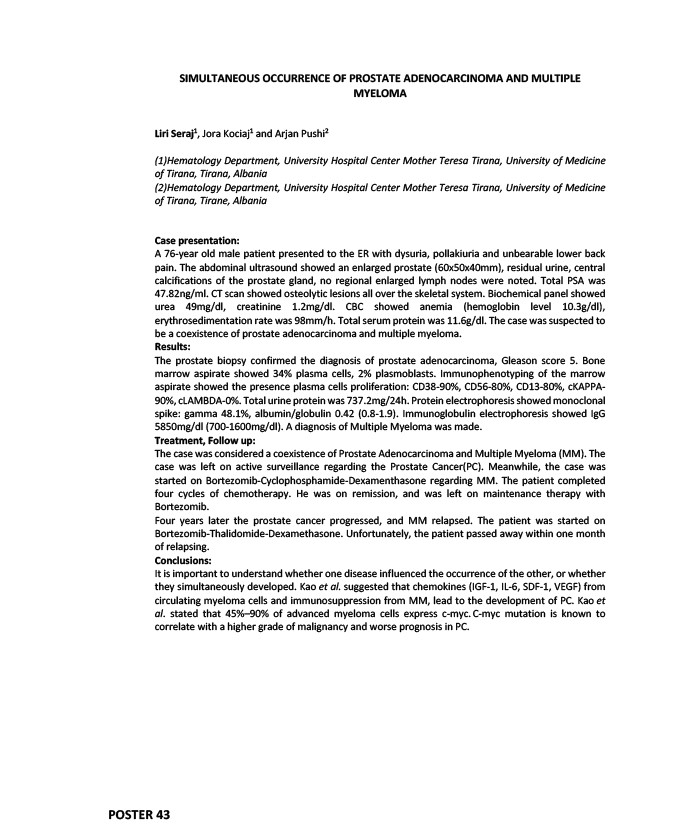
POSTER 43
SIMULTANEOUS OCCURRENCE OF PROSTATE ADENOCARCINOMA AND MULTIPLE
MYELOMA
Liri Seraj1, Jora Kociaj1 and Arjan Pushi2
(1)Hematology Department, University Hospital Center Mother Teresa Tirana, University of Medicine
of Tirana, Tirana, Albania
(2)Hematology Department, University Hospital Center Mother Teresa Tirana, University of Medicine
of Tirana, Tirane, Albania
Case presentation:
A 76-year old male patient presented to the ER with dysuria, pollakiuria and unbearable lower back
pain. The abdominal ultrasound showed an enlarged prostate (60x50x40mm), residual urine, central
calcifications of the prostate gland, no regional enlarged lymph nodes were noted. Total PSA was
47.82ng/ml. CT scan showed osteolytic lesions all over the skeletal system. Biochemical panel showed
urea 49mg/dl, creatinine 1.2mg/dl. CBC showed anemia (hemoglobin level 10.3g/dl),
erythrosedimentation rate was 98mm/h. Total serum protein was 11.6g/dl. The case was suspected to
be a coexistence of prostate adenocarcinoma and multiple myeloma.
Results:
The prostate biopsy confirmed the diagnosis of prostate adenocarcinoma, Gleason score 5. Bone
marrow aspirate showed 34% plasma cells, 2% plasmoblasts. Immunophenotyping of the marrow
aspirate showed the presence plasma cells proliferation: CD38-90%, CD56-80%, CD13-80%, cKAPPA-
90%, cLAMBDA-0%. Total urine protein was 737.2mg/24h. Protein electrophoresis showed monoclonal
spike: gamma 48.1%, albumin/globulin 0.42 (0.8-1.9). Immunoglobulin electrophoresis showed IgG
5850mg/dl (700-1600mg/dl). A diagnosis of Multiple Myeloma was made.
Treatment, Follow up:
The case was considered a coexistence of Prostate Adenocarcinoma and Multiple Myeloma (MM). The
case was left on active surveillance regarding the Prostate Cancer(PC). Meanwhile, the case was
started on Bortezomib-Cyclophosphamide-Dexamenthasone regarding MM. The patient completed
four cycles of chemotherapy. He was on remission, and was left on maintenance therapy with
Bortezomib.
Four years later the prostate cancer progressed, and MM relapsed. The patient was started on
Bortezomib-Thalidomide-Dexamethasone. Unfortunately, the patient passed away within one month
of relapsing.
Conclusions:
It is important to understand whether one disease influenced the occurrence of the other, or whether
they simultaneously developed. Kao et al. suggested that chemokines (IGF-1, IL-6, SDF-1, VEGF) from
circulating myeloma cells and immunosuppression from MM, lead to the development of PC. Kao et
al. stated that 45%–90% of advanced myeloma cells express c-myc. C-myc mutation is known to
correlate with a higher grade of malignancy and worse prognosis in PC.